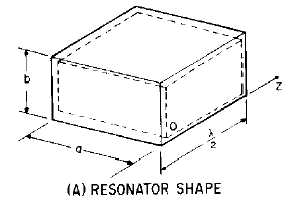1-45
advantages and uses at microwave frequencies. Resonant cavities have a very high Q and can be built to
handle relatively large amounts of power. Cavities with a Q value in excess of 30,000 are not uncommon.
The high Q gives these devices a narrow bandpass and allows very accurate tuning. Simple, rugged
construction is an additional advantage.
Although cavity resonators, built for different frequency ranges and applications, have a variety of
shapes, the basic principles of operation are the same for all.
One example of a cavity resonator is the rectangular box shown in figure 1-58A. It may be thought
of as a section of rectangular waveguide closed at both ends by conducting plates. The frequency at which
the resonant mode occurs is 1/2! of the distance between the end plates. The magnetic and electric field
patterns in the rectangular cavity are shown in figure 1-58B.
Figure 1-58A.—Rectangular waveguide cavity resonator. RESONATOR SHAPE.
Figure 1-58B.—Rectangular waveguide cavity resonator. FIELD PATTERNS OF A SIMPLE MODE.
The rectangular cavity is only one of many cavity devices that are useful as high-frequency
resonators. Figures 1-59A, 1-59B, 1-59C, and 1-59D show the development of a cylindrical resonant
cavity from an infinite number of quarter-wave sections of transmission line. In figure 1-59A the 1/4!
section is shown to be equivalent to a resonant circuit with a very small amount of inductance and
capacitance. Three 1/4! sections are joined in parallel in figure 1-59B. Note that although the



